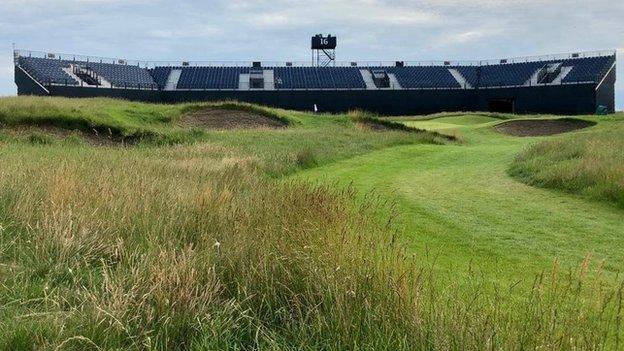The Open 2021: Royal St George's set for 149th staging of golf's oldest major
- Published
- comments

The 16th at Royal St George's may be the shortest hole on the course but it is unlikely to be the easiest
The 149th Open Championship |
|---|
Venue: Royal St George's Date: 15-18 July |
Coverage: Daily live text from 06:30 BST, Radio 5 Live from 12:00 and highlights on BBC Two at 20:00 |
Familiarity made it feel like yesterday, but in reality it had been far too long.
The Open is back for the first time in two years after the Covid-induced hiatus of 2020 and returns to the Kent coastline for the first time in a decade.
Coming back to Royal St George's holds special personal resonance. Arriving here on Sunday brought back a string of great memories, stirring eager anticipation for the 149th running of golf's oldest major.
Soon I was standing in knee deep rough, juicy and thick, and it reminded me of my first on-course commentary for Radio 5 Live as the BBC's golf correspondent back in 2003.
Viewing Tiger Woods in the distance; his ball heading in our direction, ducking to take cover, suddenly I was part of a search party after it disappeared into the long grass.
Woods was a colossus of the game at the time, yet no one found his ball promptly enough and he opened with a triple-bogey seven. More balls could again be lost there this year.
Recent major winners such as Jon Rahm, Bryson DeChambeau or the veteran Phil Mickelson are the focus this time and, no doubt, fearful of leaking a tee shot into what remains golfing jungle.
From my solitary walk of the course, with just a handful of players making an early recce, I can report that Royal St George's, the first golf club in England to stage The Open - the 34th in 1894 - is in magnificent condition.
As the only spectator on the fourth hole, I watched Viktor Hovland, the Norwegian world number 14 and a genuine contender this week, despatch a perfect drive over the fearsome "Himalaya" bunker.
Up at the green his playing partner, the American Lanto Griffin, speculated whether he could hit his severely uphill putt anywhere near the cup. "Under or over 10 feet?" he asked his caddie. He got it to about nine; it was a good putt.
This Sandwich course, which is hosting its 15th Open Championship, is all about its undulations. I let my mind wonder about the wisdom of routine range practice because there will be precious few flat fairway lies.
At the ninth I recalled Darren Clarke's fortuitous miss-hit runner onto the green in the final round a decade ago. The shot was tailor-made for the humps and hollows of this golfing ground, but he admitted it was a tad lucky.
That was a moment that suggested the stars were aligning for one of golf's greatest fairytales. And we already knew this course's capacity for generating such stories.
How else could a player ranked 396 in the world, playing his first major only a month after acquiring his American passport and effectively on his honeymoon, hold off the best golfers in the world? Ben Curtis did exactly that back in 2003.
At the 11th I had another memory from that year - commentating as Mark Roe holed for birdie. The unheralded Englishman stood, with a seemingly disgusted look, as he leaned on his broom-handle putter before his ball disappeared.
His body language fooled your rookie commentator, who had been unable to see the hole from his vantage point. "He hates it... oh it's in!" Not one for the archives, that one!
Roe went into the lead, but he was unknowingly filling out the wrong scorecard because he hadn't swapped with playing partner Jesper Parnevik. Both were cruelly disqualified - thankfully today's rules are more sympathetic.
Ten years earlier I had been here as a reporter at an Open for the first time and witnessed Greg Norman's closing 64 to land his second Claret Jug. It was pure golfing glory as he triumphed over greats such as Sir Nick Faldo.
Thoughts of that victory entered my head when I arrived at the long 14th. I listened to the sound of Jordan Spieth's approach from just short of the water known as the Suez Canal as it whistled through otherwise silent air.
His ball peeled off short right, coming up just shy of the out of bounds. Back in 1993 Bernhard Langer had been less fortunate as the then reigning Masters champion drove into those fields bordering the course.
That ended the German's tilt, just as Dustin Johnson's challenge faltered with his second shot flying OB in 2011. Another moment that told us the then 42-year-old Clarke, ranked 111th in the world, was finally about to break his major duck.
It is now late afternoon and the marshals are restless, wanting to get off to watch the final of the Euros. Realisation dawned that at precisely this time seven days hence it will be golf at the centre of sporting attention.
Someone will be heading down this par-five hole dreaming of the Claret Jug, fearful of the nightmare of hitting out of bounds.
Up at the 16th, a grandstand in the pure navy blue of the R&A's branding horseshoes the green of the final par-three, at 162 yards the shortest hole on the course.
It offers the perfect view of another scene that could define the championship. Will they put the final-day pin close to the bunker on the right that did for for Thomas Bjorn back in 2003?
Bjorn hit the fewest shots in that event, losing by one not because he took three to escape that trap but because of a two-stroke penalty for hitting sand in anger after failing to get out of another bunker earlier in the tournament.
The Dane then bogeyed the 17th, meaning Curtis's eight-foot par putt would be good enough to win. It was the first to clinch the Claret Jug I ever commentated on, sitting high above the home green in the 5 Live commentary box.
In 2011 I was at ground level having been privileged to walk all 18 holes with Clarke. As he tapped in, I remember wondering if there had ever been a more popular champion, such were the roars that swept over the ancient links.
Then again, I thought the same two years ago when Shane Lowry, our most recent Open champion, completed his mesmerising triumph at Royal Portrush.
That was a magical Open, but they all find a way to stir the sporting soul. Who will be doing that this Sunday? It is genuinely impossible to say, and that uncertainty contributes massively to the joy of the event.
Few saw Clarke as a contender, his putting seemingly in tatters a decade ago, but at least he had pedigree as a potential winner. Curtis was much more left field while Norman was an all conquering force and a natural champion.
Rahm overcame his inner demons to win his first major at last month's US Open. The Spanish world number two will need that mindset if he finds deep revetted bunkers or these capricious fairways repeatedly propel seemingly perfect drives into the rough.
It is thick and juicy, made more so by the rains that battered the course on the night of my solitary course walk. It has made the fairways a little softer but the forecast is set fair for the championship days.
One betting column ran stats from the last 10 Open winners and the metrics pointed to a Rory McIlroy victory. Another for Northern Ireland in the Garden of England?
Or will one of Matt Fitzpatrick, Tyrrell Hatton, Paul Casey, Lee Westwood, Justin Rose or another home player end 29 years of hurt. There has not been an English champion since the third of Faldo's Open wins in 1992.
British golf celebrated Sandy Lyle's triumph here in 1985, and at the end of my Sunday stroll I'm standing next to "Duncan's Hollow", much deeper than it looks on TV, and the place that nearly cost the Scot his first major title.
But surrounded by the 18th hole grandstands, I had no idea who I might be commentating on by the end of the next week. Happily, those stands will be full, with 32,000 fans expected each day.
For all of us, the fun will be finding out. A long, long wait is almost over.
